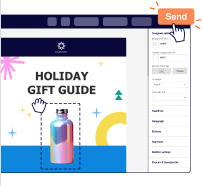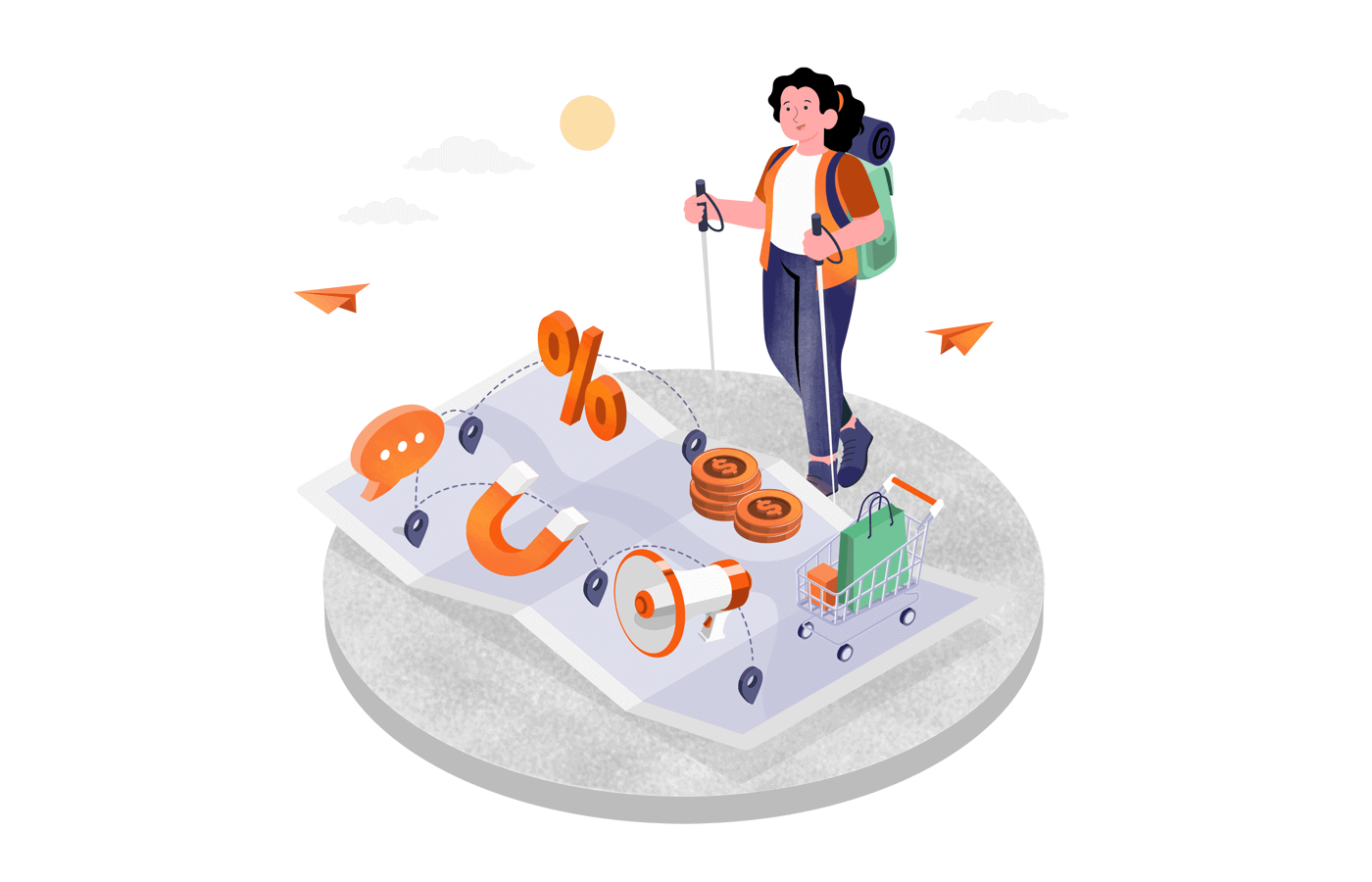So, you want to increase conversion rate? And you no doubt want to turn potential customers into loyal ones. That is the aim of the business game, after all.
What you need, then, is an email marketing strategy—one that’s built around the customer journey, from the first click to repeat purchases.
Having worked on dozens of email flows, we’ve seen this: the brands that win aren’t the loudest, they’re the ones that listen, adapt, and deliver the right message at the right moment.
In this guide, we’ll break down what a customer journey is and how you can use it to improve your email marketing operations. We’ll share various examples and some valuable insights we’ve tested over the years.
So, hang tight as this is everything you need to know to create customer lifecycle emails that actually influence people, not just fill inboxes.
Setting the Stage for the Customer’s Journey
No one sets off on a journey without some sort of a plan. Booking flights, downloading maps, researching restaurants – these are all part of the planning process. And they’re essential if you want to enjoy every moment of your travels, right?
Think of the email customer journey in a similar way. Set the stage for the customer so that each step of their journey will be seamless, painless, and even enjoyable.
So how do you know what your customer’s journey with your business currently looks like? One word: analysis.
Analyzing each stage will give you a clear picture of how customers behave, what influences the decisions a customer makes, and what might inspire new subscribers to become paying customers.
Keep in mind that there are four types of customer journeys. Before you begin analyzing, you need to define the exact customer journey email marketing map based on your goals. These include:
- Service journeys: A linear process where a customer is simply trying to get from one end to the other, for example, returning an order.
- Experience journeys: A broader linear journey that dives into how customers feel when they interact with your brand or website.
- Decision journeys: People constantly to and fro before making a decision. Analyzing website analytics data will show at what point people make a decision one way or the other.
- Life journeys: Consider the different phases in people’s lives and look at how this influences their interactions.
Try to understand how your customers think and feel at each stage and analyze relevant engagement metrics. This will help shape your email user journey map.
More importantly, it helps you influence people’s decisions so you convert them into paying customers.
Examples of Customer Journey Maps
Over the years, we’ve worked on customer journey mapping projects and understand that it plays out in very different ways, depending on the industry, business model, and how well you know your audience. There’s no ‘one-size-fits-all’ customer journey map.
That’s why you should visualize your customer journey as per your business model before planning your emails.
Here are the most common email journey mapping types and examples that you can take inspiration from:
Funnel-shaped Customer Journey Map
This is one of the most common customer journey maps and is useful in creating email funnels for ecommerce, digital products, or performance marketing campaigns. The flow is linear and helps you plug in emails at each stage to guide action.
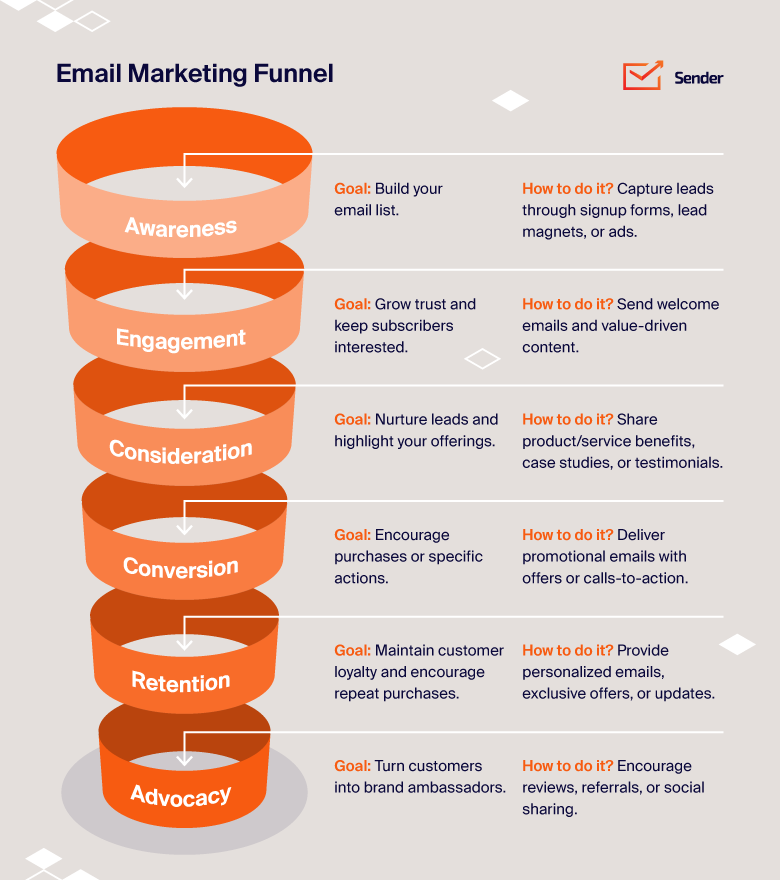
Flywheel Customer Journey Map
This is one of the most comprehensive customer journey maps you’ll see. It relies heavily on retention, community, and word-of-mouth. If you’re building loyalty and want customers to come back (or bring friends), this should be on your radar.

B2B Journey Map
This one’s designed for longer sales cycles. If you’re selling services, SaaS, or anything that needs education and trust-building. Here’s a customer journey map that shows how email plays a steady, nurturing role across customer touchpoints.

Why Email Marketing is Crucial for the Customer Journey
In the world of ecommerce marketing, it’s easy to be distracted by every new trend. Should you be using AI for text messages? Is that new social media platform as amazing as it sounds?
Amongst all the hype, the humble email stands with its head held high. Email remains one of the most effective channels for marketers to increase lead conversions and customer retention.
Why? Let’s look at some of the main reasons it works so well for the customer journey.
Personalized Customer Experience
Personalization. Personalization. Personalization. That’s what it’s all about in today’s ecommerce world.
And email marketing offers it in droves. If you’re collecting the right customer data, you can send personalized emails to cross sell products based on historic purchases. Or give them a nudge if they’ve abandoned their cart. What all this means is that you can adapt your marketing to every customer’s individual journey.
Looking for a feature-packed, easy-to-use email marketing platform? Sender’s drag-and-drop builder makes creating newsletters a breeze.
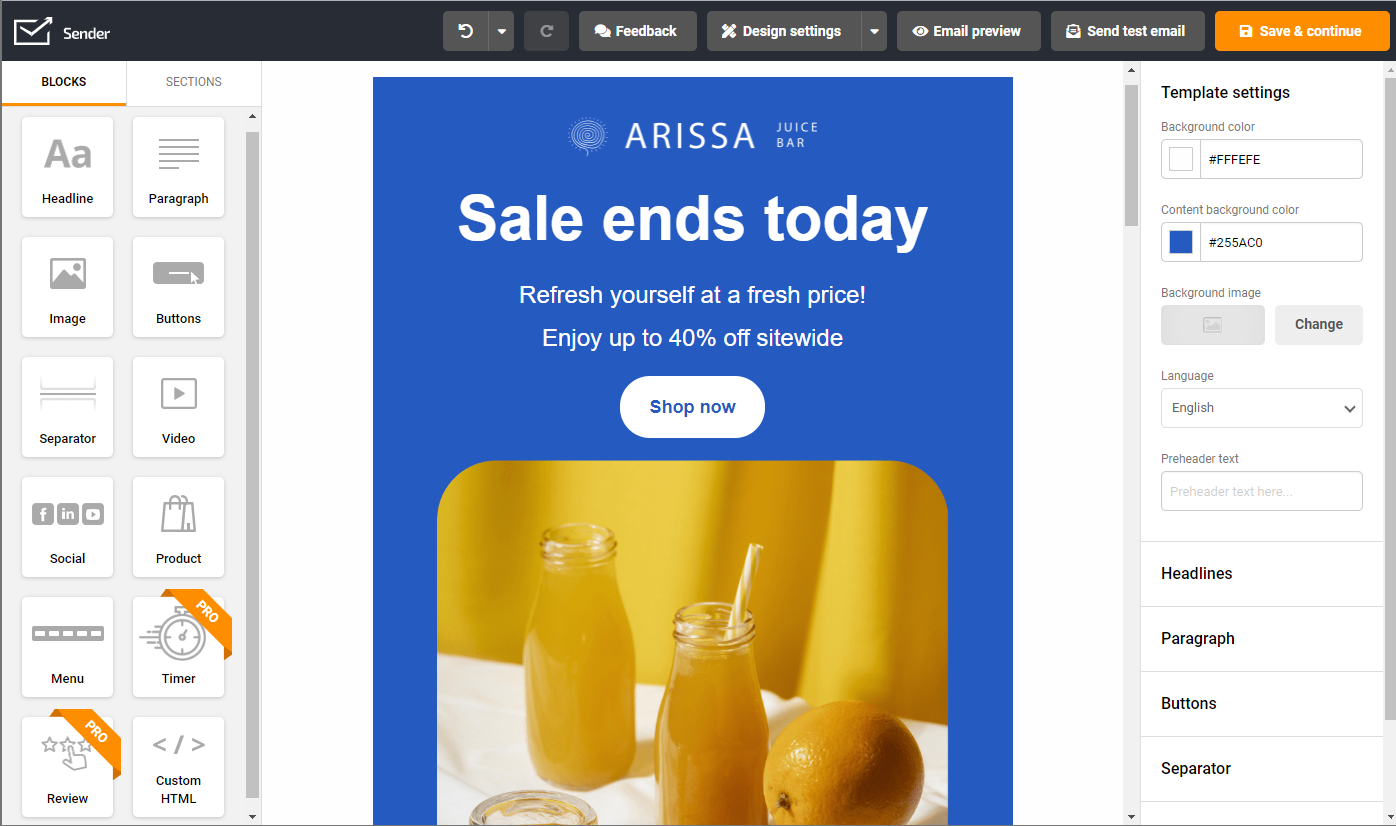
Strengthening Brand Loyalty
Every company wants a horde of loyal customers. After all, existing customers are easier to sell to as they’re already convinced by what you offer. Plus, holding on to an existing customer significantly reduces your acquisition costs.
Email marketing can help you establish and build brand loyalty. At the start of the customer journey, emails introduce customers to your brand ethos and values. Then utilizing email marketing customer journey maps will cement these values and increase brand visibility.
Emails can also be used to reward a loyal customer — because everyone knows an exclusive discount can go a long way.
Modern-Day Email Marketing
Like we said, data is powerful. Today, successful email marketers use that data to create more impactful campaigns. If the messaging is tailored to customer behavior and interests, they’re more likely to engage with it. This Playstation’s email is the perfect example.
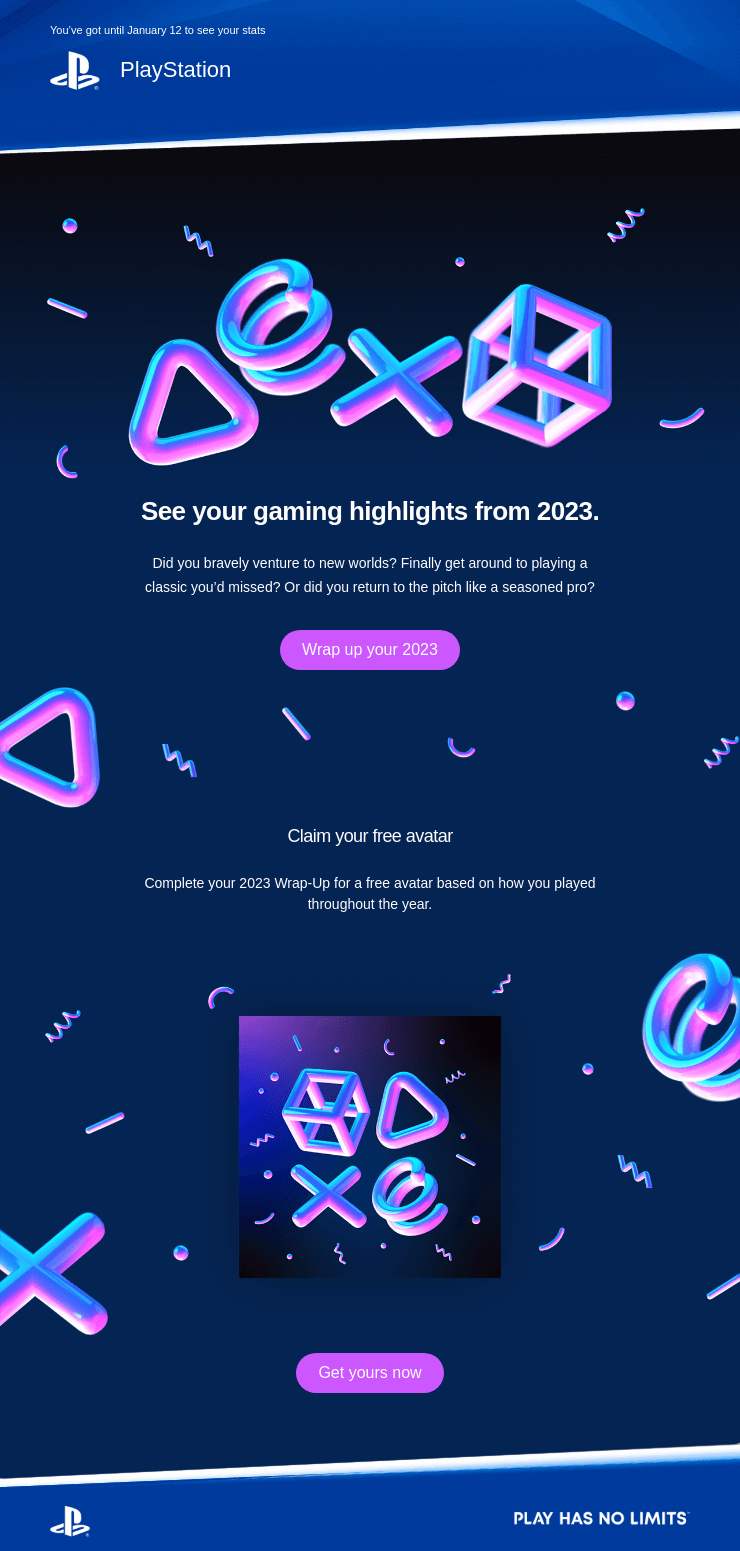
Modern campaigns also make the most of email automation. When you have access to software for marketing automation customer journeys, you can target the right people at the right time on autopilot.
Using a customer journey marketing automation tool improves your chance of registering higher conversion rates. You can send automated emails, including welcome emails, abandoned cart reminders, and reengagement emails to inactive customers with exclusive content or discount codes.
8 Customer Journey Stages
A customer journey map should cover different stages from a customer’s perspective. And to build an effective email customer journey plan, you need to understand how buyers move, step by step.
Here’s a breakdown of different stages and customer journey email examples for each:
Pre-Awareness Stage
At this stage, your potential customer doesn’t even realize they have a problem, or that your product exists to solve it.
This is where your customer journey strategy really begins: not with a sale, but with subtle signals that catch attention while your prospects are scrolling the internet.
You’re planting the first seed of curiosity. The goal? To adopt a customer-centric approach and enter their world in a natural and non-intrusive way.
Email Marketing Strategy
While email isn’t the first touchpoint for the customer journey strategy here, it plays a key supporting role.
If you’ve captured leads from top-of-funnel efforts, like quizzes, free downloads, or blog subscriptions, this is your chance to engage your potential customers and, of course, keep your existing customers engaged and build trust.
Think educational content, light storytelling, or relatable problems they didn’t know they had. Remember, this stage isn’t about pitching. It’s about positioning, setting the stage for future interest.
Send value-driven content that educates or entertains without selling. Use storytelling, industry trends, or personal experiences to make them feel seen. Here’s an example by Remarkable:

Don’t aim for conversion yet. Aim to earn trust, spark curiosity, and warm them up for the next stage.
Awareness
This is where the customer journey officially begins. They’ve become aware of your brand and are open to learning more.
But awareness doesn’t guarantee interest. That’s why your emails at the brand awareness stage should focus on making a memorable first impression that feels relevant, not random.
Think beyond just getting an email address. Ask: what will make them stick around?
You should think of gathering more information about their preferences, hobbies, etc. via an email sign-up form or follow-up conversations, all of which can help you create smarter email campaign journey maps later.
Email Marketing Strategy
At this point, they’ve likely visited your site, seen your ad, or found your Instagram page. They’ve signed up because something clicked. Now it’s your job to build on that curiosity.
The customer’s email marketing journey at this stage should focus on sending relevant emails first, and brand promotion later.
Use a welcome series that introduces your brand story, values, and what subscribers can expect next. Here’s a great example:

Personalize their experience by adding a personalized coupon code for their first purchase or referencing their signup source to improve the connection. Include social proof, founder notes, or behind-the-scenes content to build trust.
Remember, the goal here isn’t to push sales; it’s to make them feel they’ve joined something worth being part of by sending relevant messages at the right time.
Interest Stage
At this point, your customer isn’t just aware of your brand, they’re interested in your product. People are actively evaluating your offering, not necessarily to buy, but to understand if your brand or product is worth keeping in mind.
They’re skimming your website, checking out your Instagram highlights, or watching your videos without following yet. This is where interest turns into intent — if nurtured right.
From a customer journey strategy point of view, this is where emotional connection begins to matter.
Email Marketing Strategy
Use your email marketing efforts at this stage to deepen the relationship. Can you show that you understand their needs? Are you offering helpful, human, or even entertaining content that resonates?
Instead of pushing features, talk about pain points, outcomes, and real-world usage. This is the stage where you build relevance. Include clear CTAs, but keep them low-commitment, like “read more,” “see how it works,” or “watch the demo.” Here’s a great example of such an email by Gumtree:

Also, don’t forget to segment based on activity and click through rates to start personalizing content.
At this point, you’re not selling yet; you’re framing the story so your product naturally fits their life.
Consideration
By this stage, your prospective customer is thinking about buying. They’re comparing you with alternatives, reading reviews, and trying to decide if your product truly fits their needs.
The gap between interest and purchase often lives here, and closing it depends on how well your customer journey strategy removes doubts. People in this stage usually want answers, like:
- What makes your product different?
- Is it worth the price?
- What if it doesn’t work for them?
This is where transparent communication, tailored messaging, and social proof can nudge them forward.
Email Marketing Strategy
Your emails should guide decision-making during the consideration stage.
Share comparison guides, FAQs, or customer success stories that address real objections. Highlight key features, but link them to benefits and outcomes. Here’s an example by SEMRush:

Dynamic content also works well here, like showing the exact product they viewed or offering tailored recommendations.
Add testimonials, case studies, or limited-time incentives to nudge them to act. The tone should be reassuring, confident, and supportive, like a helpful friend, not a pushy salesperson.
Intent Stage
The intent stage is where interest becomes action-oriented. They’ve done their research and are mentally close to buying, but they still need that final push.
They might have added something to their cart, checked your pricing page, or explored product reviews.
This is a crucial point in your customer journey strategy, because intent without support often leads to drop-off.
Email Marketing Strategy
Intent-focused emails should reinforce urgency and clarity. Your job now is to remove friction and make buying feel like the obvious next step.
Think about what’s stopping them? Shipping doubts, unclear return policies, pricing confusion, or simply ‘I’ll do it later’. Here’s a great example that uses urgency, incentive, and social proof, all at once:

The email is a great example on how you can influence a buying decision. Selfmade has used FOMO in the headline followed by real reviews that are a strong social proof. The CTA button is prominent too, tempting users to avail the deal.
Remember to remind them what they loved, add trust signals (like reviews or guarantees), and use light urgency (limited stock, expiring offers) like the example. You can also offer contextual support, like a “Need help choosing?” message or live chat option.
The goal here should be to use key elements to clear the path, calm the nerves, and nudge the click.
Decision
This is the moment of truth — your customer is ready to make a purchase. They’ve done the research, weighed their options, and are leaning toward choosing you.
But even here, hesitation is real. One small roadblock — like a complicated checkout process, lack of payment options, or last-minute doubt — can cost you the sale.
Your customer journey strategy should focus on reducing friction and reinforcing confidence. They don’t need more convincing — they need reassurance.
Is your brand reliable? Is the buying process smooth? Can they trust that what they see is what they’ll get? Everything you do here should say: “You’re in safe hands.”
Email Marketing Strategy
This is the purchase stage where your emails should act like a confident guide.
Send abandoned cart emails with a clear, clean CTA, like “Complete Your Purchase” or “Your Pick Is Still Waiting.” Here’s a great example by Rebel Rabbit:

Include return policies, shipping timelines, and guarantees to reduce anxiety. This is also a great place to offer one-time incentives, like a small discount, free shipping, or a freebie can tip the scale.
Keep the tone warm and reassuring, and show up at the right time, especially if they’ve shown intent signals like visiting the cart multiple times.
Post-Purchase Engagement
The sale is done, but your work isn’t. In fact, this stage is where brand trust is either strengthened or silently lost.
Customers who’ve just made a purchase are still evaluating their decision. If you go silent, they might forget you. Or worse, they might regret the purchase and have second thoughts. So, you should think of creating a fulfilling and positive post purchase experience via emails.
Your strategy should treat this post-purchase phase as a chance to turn buyers into believers.
Deliver value, show up with helpful support, and build the kind of trust that leads to repeat business.
Email Marketing Strategy
Start with a personalized email thanking your customer. Include order details, expected delivery timelines, and a human note.
Follow up with onboarding content or care tips, like how to use the product, FAQs, or setup videos. Here’s a nice example of a similar post-purchase email:

You can also ask for feedback or reviews once the product is delivered, it makes customers feel heard and helps you improve. Also, introduce them to your community, referral program, or loyalty perks.
Remember, email marketing success at this stage is about making the customer believe that they’re a valuable member of a community.
Loyalty & Advocacy Stage
This stage is all about building long-term relationships through personalized email marketing. Loyalty builds through consistent value, memorable experiences, and trust.
If a customer comes back to buy again, you’ve done something right. But true business growth happens when they bring others along, without being asked.
At this stage, your plans should now focus on two things: retention and referral through re-engagement.
It’s easier (and cheaper) to sell to someone who already trusts you. Plus, word-of-mouth marketing has the potential to become your most powerful growth engine. But it doesn’t happen by default. It happens by design.
Email Marketing Strategy
Your customer loyalty emails should focus on customer engagement, exclusivity, customer satisfaction, and rewards.
Send early access to new collections, surprise discounts, or loyalty perks to repeat customers.
Build a referral loop with a simple, no-pressure ask, like “Love us? Share with a friend.” Share user-generated content, feature loyal customers, or invite them to a VIP group. Here’s an example:
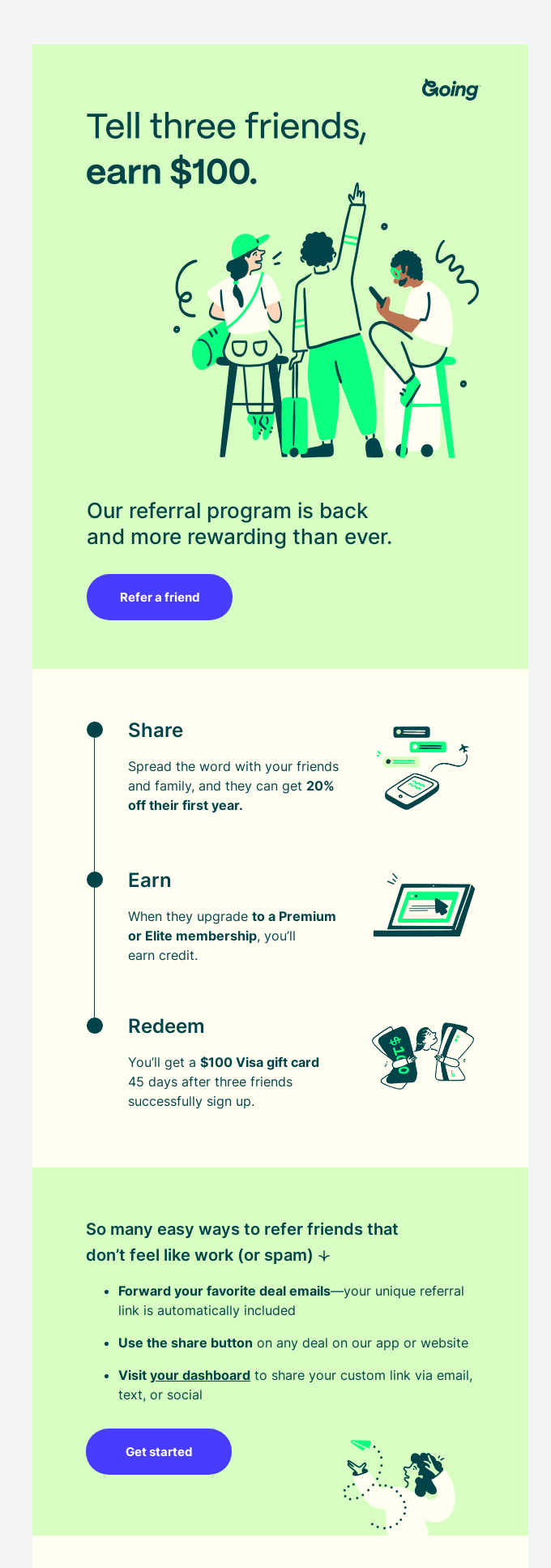
Keep showing up with value regularly and not just offers. Now, the goal is to make customers feel appreciated, seen, and part of your journey.
Common Pitfalls and How to Avoid Them
In your email marketing strategy, it is easy to make little mistakes that have a big impact. You wouldn’t be alone either — there are many common pitfalls that could put off customers rather than persuade them to carry on through their journey. Here are some common ones:
Spamming Customers
We get it: securing new email subscribers is exciting. It’s tempting to send them a slew of emails about your brand mission, founding team, top-selling products, upcoming sales… The list goes on.
But there’s a difference between engaging your subscribers and bombarding them. So make sure you find the sweet spot. Send just the right amount of buyer journey emails to keep their attention, and focus on genuine offers and messages.
But wait, we hear you ask. How do I know what the “right number” is? Great question. There is no magic answer to that question, nor is there a one-size-fits-all approach to email marketing. However, this is where the earlier process of analyzing your customers’ journey will help.
Of course, you should have a standard welcome cycle for new subscribers. But you also need to consider what information, support, or encouragement they need throughout their journey. Then, consider what emails you can send to help them gather more information, make decisions, complete transactions or returns, or even offer feedback.
It is recommended to send an email at least once a month, but use this as a rough guide. Research shows that marketers actually send email marketing campaigns weekly or even several times a week.
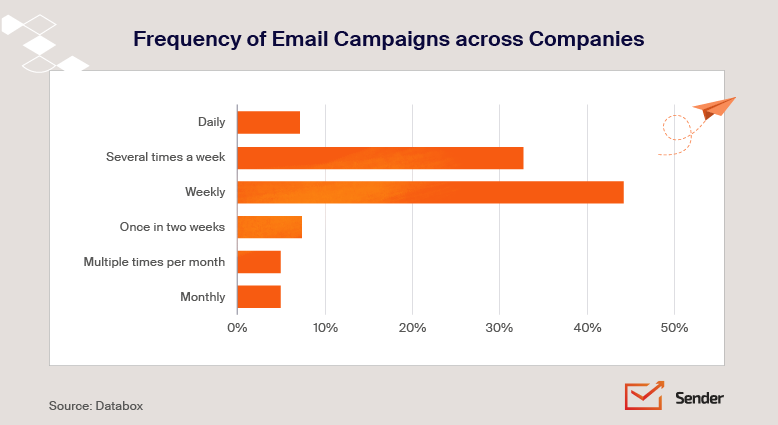
So figure out a frequency that works best for you and your customers. Adapt your schedule to the email marketing journey map stage that your customer is on. And remember that send frequency is likely to ramp up around promotional periods like Black Friday or Valentine’s Day, so plan ahead.
Using Misleading Subject Lines
Crafting an engaging email subject line is a great way to encourage customers to open your email. However, these should never be misleading or overly gimmicky. You don’t want customers unsubscribing or marking emails as spam, do you?
Misleading subject lines often overuse capitalization, punctuation, and emojis as well as trigger words and phrases, such as:
- “Earn”
- “Free”
- “Get Paid”
- “Lose Weight”
- “No Catch”
- “Money Back”
- “Limited Time”
- “The Best”
Including any of these tactics is likely to result in your email being sent straight to spam. On top of this, avoid misleading, vague, or over exaggerated subject lines that might cause confusion or even anger.
For example, a subject line like Out of Office! might feel creative for an email marketing campaign promoting summer holiday must-haves. But this can cause your email to be filtered to spam or confuse customers that do open it.
Similarly, subject lines that start with RE: can be seen as a deceptive way of tricking customers into thinking they already have an ongoing email chain with the sender.
If you make sure your subject lines are always relevant to the content and your brand, you’ll be in good shape.
Also read: Email Subject Lines Capitalization
Not Updating Your Email List
Effective email list management is essential. You need a process or tool that ensures your list of leads is always up-to-date and relevant. This means your personalization efforts will be more effective, plus it guarantees you aren’t sending emails to people who have unsubscribed.
Forgetting about Optimization
Does your email look just as great on a phone as on a PC? What about tablets?
Failing to optimize viewing means that customers will simply delete emails that are difficult to read on the phone, leading to thousands of missed potential conversions. If you’re unsure of what to change, you could use customer feedback to improve optimization.
Not Implementing DMARC for Email Authentication
DMARC helps prevent phishing and email spoofing by telling email recipients about the legitimacy of the sender’s domain. Make sure to configure DMARC settings for your domain to enhance email security and protect your customers from phishing attempts.
In addition to avoiding the above common pitfalls, make sure you generally strive to maintain standards in your email marketing. Explore some tips for email etiquette and you’ll be on your way to a high level of professionalism and engagement.
